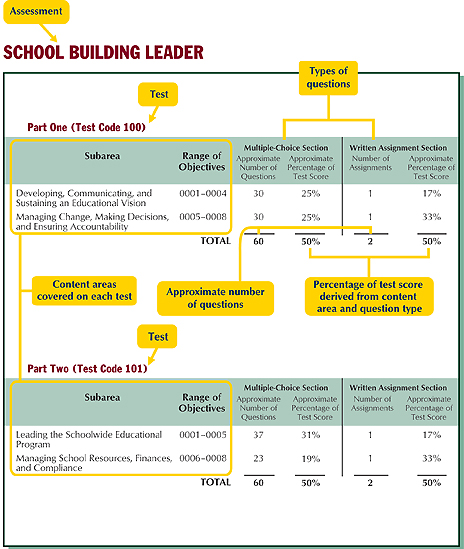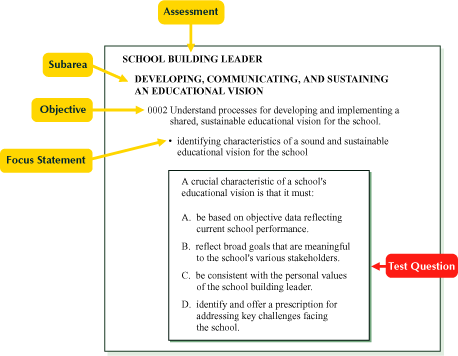Preparing for the Test
The purpose of the New York State Teacher Certification Examinations™ (NYSTCE®) School Leadership
Assessments is to help ensure that certified school- and district-level leaders have the essential knowledge
and skills necessary to provide effective educational leadership in New York State public schools. These assessments
have been developed by the New York State Education Department (NYSED), New York State educational leaders, and the
Evaluation Systems group of Pearson in response to new regulations that became effective in 2006 for preparing,
testing, and certifying educational leaders in New York State. The assessments are based on the principles of
Essential Knowledge and Skills for Effective School Leadership developed by the New York State Board of Regents'
Blue Ribbon Panel on School Leadership.
This preparation guide provides information to help you prepare to take the NYSTCE School Leadership Assessments as follows:
-
This section includes information about available resources and their use in understanding the design
and content of the assessment, and strategies for success on the day of the test.
-
The following sections contain sample test questions and additional test materials to assist you in your preparation.
Understanding the Design and Content of the Test
The content knowledge assessed by the NYSTCE School Leadership Assessments is described in the test design and assessment framework for each assessment. You may view, print, or download the test design and assessment framework for any of the School Leadership Assessments on the NYSTCE website. The following section describes how to use the test design and assessment framework to understand both the design and content of the School Leadership Assessments.
Test Design
Read the test design to familiarize yourself with the structure of the assessment. The test
design outlines the following assessment components:
- the content areas covered on each test within the assessment
- the approximate number of questions for each content area
- the types of questions (multiple-choice questions and written assignments) contained on each test
- the percentage of your total test score derived from each content area and question type
The following example illustrates the information provided by the test design.

Assessment Framework
Read the assessment framework to understand the content covered by the assessment and to determine your preparedness to
test. The framework for each assessment is divided into two parts, each of which is measured by its
own test. Each test is organized into subareas, objectives, and focus statements as follows:
-
Subareas define the major content domains of the assessment. Each test contains two subareas. Subareas
typically consist of several objectives. The number of objectives may vary, depending on the breadth of content contained
in the subarea.
-
Objectives define the knowledge and skills that New York State educational leaders have determined
to be important for educational leaders to possess. Each objective is expanded upon by focus statements.
-
Focus statements provide examples of the range, type, and level of content that may appear on the
test for questions measuring the objective.
Test questions are designed to measure specific content within each test. Each written assignment measures
the content defined by a specific subarea of the test.
Each multiple-choice question measures the content defined by a specific subarea of the test. The number of objectives
within a subarea generally determines the number of multiple-choice test questions that will address that subarea's content
on the test. Subareas that consist of more objectives will receive more emphasis on the test than subareas that consist
of fewer objectives.
The following example from the School Building Leader assessment framework illustrates the relationship of a multiple-choice
test question to the test, subarea, objective, and focus statement in the framework to which it corresponds. This same direct
relationship between multiple-choice test questions and their corresponding objectives applies to all NYSTCE assessments.

Strategies for Success on the Day of the Test
Review the following strategies to help you do your best when taking the NYSTCE School Leadership Assessments.
| Follow directions |
Follow all directions. This includes directions given to you by test center staff
and all written directions.
|
| Take the tutorial |
Before beginning the test, you will be given an on-screen tutorial that will show you how
to navigate through the test, how to indicate your answers, and how to use the features of the computer-based test. To prepare
for the computer-based testing experience, you can also take a tutorial ahead of time at
www.pearsonvue.com/nystce. You can also access this tutorial and other helpful tutorials at "Computer-Based Testing Tutorials."
|
| Pace your work |
The test schedule is designed to allow sufficient time for you to complete your test. To assist you in pacing your work, a clock
icon is visible in the upper right-hand corner of the test screens. This clock indicates the test time that remains. At any time,
you may check which questions you have answered and how many remain, to help you determine whether you are progressing through the
test at an appropriate speed. Remember to leave enough time to respond to the written assignments.
|
| Read carefully |
Do not try to save time by skimming directions or by reading the test questions quickly. You may miss
important information and instructions.
|
| Determine the "best answer" |
Your response to each multiple-choice question should be the best answer of the alternatives
provided. Read and evaluate all four answer choices before deciding which one is best.
|
| Guess wisely |
Your results on the multiple-choice section of the test will be based on the number of questions you answer correctly.
You will not be penalized for guessing. If you are unsure about a question, use your knowledge of the content area to
eliminate as many of the alternatives as you can. Then select among the remaining choices.
|
Respond to the written
assignments fully and clearly |
Be sure to read and respond to each part of the written assignments. Note the word count range
suggested in the test directions for the length of your responses. A word count feature is provided for the written assignments
so that you can see the length of your response as you write it.
|

